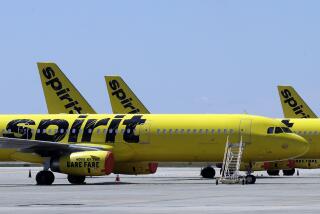No Free Ride in Airline Merger
- Share via
American Airlines is hoping to get a free ride from the Department of Justice in its merger with TWA. After all, it is acquiring an airline that has been in and out of bankruptcy courts over much of the last decade and hasn’t posted a profit since 1988. But it’s not that simple. American is also acquiring a 20% chunk of US Airways, another struggling airline, in a deal that is intended to clear regulatory hurdles for United Airlines’ acquisition of the remaining 80% of US Airways. Combined, these transactions will put American and United in control of roughly half of the U.S. market. The Justice Department should examine these deals closely to see what they will do to air travel competition, and Congress should take a broader look at the airline industry to make sure public interest isn’t lost in the corporate reshuffle.
Announcements of airline mergers--and there have been many before--always meet with protest from consumers who fear less competition will lead to higher prices and poorer service, and almost never has that been the case. During the last wave of airline consolidations, in the late 1980s, nine airlines merged within two years. Since then, air fares, adjusted for inflation, have dropped 20%. Critics predicted that the 1987 merger of US Airways with the dominant California air carrier, Pacific Southwest, would kill competition on West Coast routes. Instead, US Airways lost much of its business to better-run regional competitors.
This does not mean Justice should accept the airlines’ merger plans at face value. The air transport picture is a lot less varied today than it was a decade ago. United and American will tower over their nearest competitors, affecting one out of every two passengers. What this will do to prices is uncertain, but many routes up and down the East Coast are likely to be affected, along with deeply discounted TWA routes. And a strike at either airline would have a far greater impact on air travel than any such strike today.
A merger may well be the best solution to the problems faced by the beleaguered TWA and US Airways and their employees. But that’s not where the analysis should end. Clearly, the merger mania in the airline industry is not over yet. Delta, Northwestern and Continental are looking for ways to align as well. Some analysts predict that by the time the shakeout ends, the country will be left with four or five major airlines.
The impact of an individual merger on routes, prices and quality of service is difficult to predict. What is clear is that, with so much concentration in the industry already, each merger changes the face of the entire national air transportation system. Transportation authorities and Congress should make sure the airlines don’t leave passengers behind.
More to Read
Inside the business of entertainment
The Wide Shot brings you news, analysis and insights on everything from streaming wars to production — and what it all means for the future.
You may occasionally receive promotional content from the Los Angeles Times.










